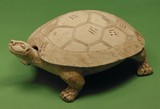
 |
Chinese (Han dynasty) Tortoise-Shaped Inkstone 206 B.C.-A.D. 220 Gray earthenware 4 inches high, 10 inches long William Hood Dunwoody Fund 32.54.4a,b |
Look
- What kind of animal is this? How can you tell? Does it look like a
real tortoise? Have you ever seen a tortoise? What physical characteristics
of a tortoise are depicted to make it look NATURALISTIC?
What aspects are not naturalistic?
- Can you tell what material was used to make this inkstone? Where did
the artist find the material? Have you made anything out of clay?
- Do you think this inkstone was made (a) on a potter's wheel,(b) using
the coil method,(c) with a mold, or (d) by the slab method? Explain
your answer.Do you think this inkstone was difficult to make? Why do you
think so?
- What kinds of lines do you see? What shapes do you see? Are they GEOMETRIC
or ORGANIC shapes? Where do you see PATTERNS?
How are these patterns made?
Think
- Explain the significance of tomb figures and the belief in an afterlife.
Why would a Chinese scholar want to bring a tortoise-shaped inkstone
into the afterlife? Why do you think a tortoise was important to the
Chinese? Why do you think an inkstone was important to a Chinese scholar?
If you could bring something with you into the afterlife, what would
you bring? Why would you choose that? What purpose would it serve?
- How would you describe this tortoise? Do you think this tortoise is
kind or mean? Why do you say that? What about the tortoise conveys friendliness?
- What other objects in this unit may have been made to include in a
tomb? In what ways are these objects similar? How are they different?
- Do you think this tortoise-shaped inkstone has one or two parts? Look
closely. Where do you think it comes apart? Why would it have a lid?
Do you think it is hollow inside? The Chinese scholar used the inkstone
to grind and mix ink for writing. What would you use it for today?
- How is this work similar to the tomb retinue earth spirits? How is it different?
![]()
Key ideas.
Where does it come from?
What does it look like?
How was it used?
How was it made?
Discussion questions.
Additional resources.
Select another piece.